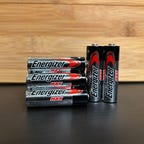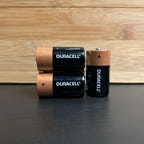A reliable set of alkaline batteries will ensure it’ll be a long time before you’re out and about looking for replacements. The best alkaline batteries are long-lasting power sources, ensuring you get plenty of use out of your everyday devices and appliances, be it TV remotes, flashlights, toys or more.
To pick the best alkaline batteries available, we put several popular models and brands through an extensive discharge test to see which batteries lasted the longest — across AA, AAA, C, D and 9-volt options — while keeping in mind the cost for how many batteries you got for your purchase.
None of these options are rechargeable batteries, which might be a sensible choice for those looking to reduce e-waste over time — but with alkaline battery sales having reached $8.84 billion across the US in 2023, there’s still huge demand for the technology that shows no signs of letting up.
Here are our picks of the best alkaline batteries and how each model performed in our tests, starting with Amazon’s own brand of AAA batteries.
Read more: 43 Best Christmas Gifts and Ideas for Every Price Range
The competition for the best AAA battery was closely contested, as all competing brands demonstrated similar performance in our discharge test. Affordability and reliability played a significant role in our evaluation.
Amazon AAA batteries emerged as the most reliable during our discharge test, exhibiting consistently repeatable results across three different runs and boasting the longest average discharge time at 28 minutes, 32 seconds.
Moreover, if you’re considering buying in bulk, this option is, by far, the better choice. The 36-pack is currently priced at less than $16 at the time of this publication, translating to approximately 43 cents per unit. Now that’s true value.
AA batteries are likely the most popular battery size, given their widespread use in a variety of electronic devices. They don’t hold as much charge as a C or D battery, which means you’re probably going to be replacing them a lot. Again, it comes down to bulk price and performance.
The two leading AA battery brands, Energizer and Duracell, stood out in the competition, displaying similar performance, with Energizer having a slight edge. The decisive factor turned out to be price. A single Energizer AA Max battery powered three fan motors arranged in parallel for an impressive average of 30 minutes, 15 seconds, marking the best score among the group.
Furthermore, Energizer AA Max batteries are the second most affordable option. The 20-pack is currently priced at approximately $13 at the time of this publication, equating to around 65 cents per unit. With outstanding performance and an affordable price, if you’re in the market for AA batteries to power your holiday gifts or any other device, this is the optimal choice.
This one was straightforward. Duracell outperformed its competition convincingly. The only caveat is that this may not be your most budget-friendly option. Since C batteries are primarily used for medium-drain devices like cameras, radios, and even some intruder alarms, longevity and reliability are paramount.
In our discharge test, Duracell C-type batteries powered four fan motors in parallel for an outstanding average of 25 minutes, 42 seconds, nearly doubling the average duration achieved by other competing brands. Quality sometimes comes at a price, and Duracell C batteries are no exception. The 10-pack is priced at roughly $20 at the time of this publication, totaling roughly $2 per unit, the highest price per unit in this category.
D batteries are predominantly used in high-current drain devices that require prolonged running times and emergency gadgets such as flashlights, radio transmitters, and even some water heaters. It should come as no surprise that, in this case, we particularly value performance over price.
Amazon D batteries excel in performance. They were able to sustain our five-motor parallel circuit for nearly 18 minutes on average, the highest score in this category. Impressively enough, they maintained a voltage output higher than 1.2 volts throughout each of the three runs. That’s a lot of juice.
That said, they are the second priciest option on our list. The 12-pack is priced at approximately $17 at the time of this publication, translating to roughly $1.4 per unit.
9-volt batteries deliver higher voltage but possess less overall charge, resulting in a shorter lifespan compared to their 1.5-volt counterparts. They are ideal for high-voltage, low-drain applications such as smoke alarms, portable electronics, tools and even the multimeter used in this test.
In our focused analysis, we observed the battery’s ability to maintain high voltage output throughout its usable life. Amazon 9-volt batteries not only significantly outperformed other brands in terms of discharge time and voltage output under load but also stood out as the most cost-effective option, priced at only $1.62 per unit at the time of this publication, making it the only brand we tested in this category available for less than $2 per unit. In our discharge test, Amazon 9-volt batteries sustained our battery test rig for over 36 minutes — nearly three times longer than their competitors. This makes them the clear winner across all metrics.
How we test batteries
For this round of testing, we gathered four of the most popular battery brands and tested five battery categories, including AAA, AA, C, D and 9-volt. Our objective was to find out which battery manufacturer offered the best value for your money. To assess battery performance, we used our custom-built battery test rig and timed the longevity of each battery, paying attention to their voltage output over time, and compared the difference in price per unit.
Battery performance and voltage drop
Measuring battery voltage output is more complex than simply sticking multimeter probes on the positive and negative ends of the battery. For instance, AA, AAA, C and D batteries are rated at 1.5 volts. If you measure voltage output directly on the battery, the reading may be close to 1.6 volts, which is generally a good sign for a new battery. Even batteries that are no longer usable can display a value equal to or higher than 1.5 volts when measured directly. The correct approach is to test voltage output under a load condition, such as when the battery is connected to a resistor or powering a device. Meet the CNET Labs Battery Test Rig:
Custom-built battery test rig. It accommodates five battery types, including AAA, AA, C, D and 9-volt. The breadboards and connections allow for parallel and series circuit arrangements, depending on battery voltage.
Components include two breadboards, one for 1.5-volt batteries and one for 9-volt, six motor fans that can be arranged conveniently either in series or in parallel, a switch for each circuit, one multimeter for voltage readouts, a chronometer and five battery slots for each type of battery: AAA, AA, C, D and 9-volt.
The testing logic is simple but revealing. To get the full picture, let’s refresh ourselves with a bit of electronic basics. The number of active load components and the circuit arrangement depend on the type of battery under test. For the 1.5-volt group (AAA, AA, C and D batteries), we arranged the circuit loads in parallel, increasing the number of loads according to the capacity of the battery. This ensures that, regardless of the power source and number of loads, all load components are exposed to the same amount of voltage from such a power source — in this case, any of the 1.5-volt batteries. For example, AA batteries are tested using three motors in parallel, ensuring that all three motors get 1.5 volts each.
Parallel arrangement of our test rig. From left to right, the 1.5-volt battery source (either AAA, AA, C or D), a voltmeter, and motor array. The setup allows two motors to be active at all times, allowing the addition of up to five motors in total.
For the 9-volt types, we arranged six load components in series. A series arrangement evenly distributes the voltage from the power source across all load components. Since each of our fan motors takes at least 1.5 volts to run, using a 9-volt battery provides 9-volt/6 loads = 1.5-volt per load.
Six motors are arranged in series. The 9-volt battery provides equal voltage distribution (1.5-volt) across each of the loads.
Having established the basics, we proceed to testing. First, we ensure to connect our multimeter probes in parallel and take an initial voltage reading. Then, we make sure our circuit arrangement is adequate for the type of battery under test and flip the switch to on. We start our timer and monitor the test, recording data readouts for voltage output under load every minute until the very last fan stops spinning. We run a “last man standing” competition. In our test logic, the battery that sustains the load arrangement the longest wins. The voltage drop allows us to see how efficiently the battery maintains a high voltage output given the test conditions. In this regard, the slower the drop in voltage, the better.
Here are the results, starting with an overall look at the average discharge time for each battery we tested. Longer bars indicate batteries that lasted longer in our test rig.
Here’s a more detailed look at those results, with the specific, minute-by-minute dip in the average voltage readings for each battery during each test. Again, we’re looking for the batteries that last the longest in this test, but more specifically, we’re looking for batteries with as gradual a voltage drain as possible.
Price per unit
The cost of batteries can vary greatly depending on where and when you buy them. For that reason, we sought out the most economical source for each battery and compared the price per unit. Check out the table below, which we’ll update regularly:
Other alkaline batteries we’ve tested
Duracell AAA: Second-highest price per unit but a close contender for best performance. Not a bad deal.
Energizer AAA: Lowest performance among the options, and the second most affordable. Not the best quality choice.
Amazon Basics AA: Impressively low performance, nearly half the average run times of competitors. However, it’s the cheapest option.
Duracell AA: Highest price per unit, but the second-best performer and a close contender for the best pick.
Rayovac AA: Second most costly AA battery with moderate performance. Not necessarily the top option available.
Amazon Basics C: Lowest price per unit among C types, significantly cheaper than the competition. A good choice for bulk purchases.
Energizer C: Priced closely with others but lacking in performance, securing last place with an average run time of only 4 minutes.
Rayovac C: Priced similarly to competitors, offering low performance but not the worst.
Energizer D: A potential splurge pick with great performance but higher cost compared to others.
Duracell D: Falls in the median for both performance and price, lacking any remarkable features.
Rayovac D: The most affordable D battery, suitable for bulk purchase with acceptable performance.
Energizer 9V: Hard to justify due to its higher price and failure to outperform the competition.
Duracell 9V: The most expensive option, tying for last place with Rayovac in terms of battery lifetime.
Rayovac 9V: Takes the last place in performance but offers better pricing than the competition.
Rayovac AAA (out of stock): Most expensive AAA battery with room for improvement in performance, ranking second to last.
Alkaline batteries FAQ
Alkaline batteries are disposable batteries that use MnO2 (manganese dioxide) and Zn (zinc) as electrodes to generate electrical power. They are known for their reliability and are commonly used in a wide range of electronic devices.
It’s not recommended. Each size provides a specific voltage and capacity tailored to certain devices. Incorrect sizing may lead to improper functioning or damage to your electronic devices. I wouldn’t risk it.
Store them in a cool, dry place at room temperature, avoiding extreme temperatures and especially humidity. Proper storage helps maintain their performance over time. Always remember to take batteries out of toys and electronics you don’t plan on using for a long time.
Alkaline batteries typically have a shelf life of several years, but it’s important to check the expiration date on the packaging. Expired batteries may experience reduced performance. Remember to properly store them to aid in longevity.
 meganwoolsey Home
meganwoolsey Home








